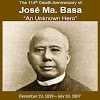In commemoration of William Oliver's 1 st year death anniversary September 10, two separate events will be held simultaneously today to honor his contribution to the biodiversity conservation of the Philippines.
William was a British national, who spent more than two decades in pioneering some conservation efforts in most biologically important sites in the country before he died at age 67 last year, due to serious illness.
The Philippines Biodiversity Conservation Foundation Inc., in cooperation with the Foundation for the Philippine Environment and the Department of Environment and Natural Resources Region VII, will launch in Cebu today a book especially dedicated for William. The book is on the status of Cebu's biodiversity.
The University of the Philippines Los Baños – Museum of Natural History, meanwhile, will open an exhibit that will show William's art pieces and other collections.
William was known for his original and iconic artworks on the threatened endemic species of the Philippines that were printed in posters, entitled “Only in the Philippines”. Aside from being a wildlife biologist, William was a great wildlife artist, who has been commissioned by some international organizations to design stamps, posters, and other communication materials that illustrated various unique flora and fauna.
William contributed hugely in ensuring the survival of highly threatened endemic species in the Philippines. Based on the survey that many of our endemic species are highly threatened and not secured in the wild, he established the conservation breeding of some threatened species, in cooperation with local and national institutions, particularly the Department of Environment and Natural Resources, Negros Forest and Ecological Foundation Inc. in Bacolod City, West Visayas State University in Iloilo, and Silliman University in Dumaguete City.
These species include the Visayan spotted deer, Visayan warty pigs, Visayan and Rufous-headed Hornbills, and Negros bleeding heart, among others. Some of these species are now ready for reintroduction back to their natural habitats.
During his early days in the Philippines, William also closely worked with Gerry Ledesma, not only for NFEFI, but also securing the Danjugan Island in Brgy. Bulata, Cauayan, to become a conservation site.
Because of the need to put in place site conservation actions, William organized several local nongovernment organizations to primarily cater to biodiversity issues and concerns. It was him who organized the Cebu Biodiversity Conservation Foundation Inc., the Mindoro Biodiversity Conservation Foundation Inc., and the Polillo Islands Biodiversity Conservation Foundation Inc.
The formation of these local groups was motivated by biological surveys that areas where these organizations operate have significant threatened endemic species. Eventually, William took the lead in organizing the PBCFI to coordinate and implement biodiversity conservation measures at the national level. He invited me, former Negros Occidental governor Rafael Coscolluela, environment lawyer Ipat Luna, businesswoman Lupe Garcia, and congressman Ace Durana to join him in the PBCFI.
William was also known to work with other organizations and individuals in the field of biological research. He was responsible for providing specimen that eventually described the Mindoro warty pig, which was named after him, the Oliver's warty pig ( Susoliveri). He also supported field surveys that discovered the existence of Negros naked-backed fruit bat or Philippine bare-backed fruit bat (Dobsoniachapmani) in Cebu. This fruit bat was first recorded in Negros and was thought extinct until it was discovered to exist also in Cebu, and later on rediscovered in Negros.
William further supported several biological surveys that led to the discovery and rediscovery of some endemic species of the Philippines. He mentored numerous individuals in biological research and development, and implemented site and species-focused conservation action plans. William also assisted several Filipino biologists to obtain advance studies here and abroad.*









0 Comments